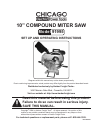
Page 9SKU 91995 For technical questions, please call 1-800-444-3353.
GROUNDING
Improperly connecting the grounding wire can result in
electric shock.
Check with a qualied electrician if you are in doubt as to
whether the outlet is properly grounded. Do not modify
the power cord plug provided with the tool. Never remove
the grounding prong from the plug. Do not use the tool if
the power cord or plug is damaged. If damaged, have it
repaired by a service facility before use. If the plug will not
t the outlet, have a proper outlet installed by a qualied
electrician.
Grounded Tools: Tools with Three Prong Plugs
Tools marked with “Grounding Required” have a three wire cord and three prong
grounding plug. The plug must be connected to
a properly grounded outlet. If the tool should
electrically malfunction or break down, grounding
provides a low resistance path to carry electricity
away from the user, reducing the risk of electric
shock. (See 3-Prong Plug and Outlet.)
The grounding prong in the plug is connected
through the green wire inside the cord to the
grounding system in the tool. The green wire
in the cord must be the only wire connected to
the tool’s grounding system and must never be attached to an electrically “live”
terminal. (See 3-Prong Plug and Outlet.)
The tool must be plugged into an appropriate outlet, properly installed and
grounded in accordance with all codes and ordinances. The plug and outlet
should look like those in the following illustration.
(See 3-Prong Plug and Outlet.)
Extension Cords
Grounded tools require a three wire extension cord. Double Insulated tools can
use either a two or three wire extension cord.
As the distance from the supply outlet increases, you must use a heavier gauge
extension cord. Using extension cords with inadequately sized wire causes a
serious drop in voltage, resulting in loss of power and possible tool damage.
(See Table A.)
1.
2.
3.
1.
2.
WARNINGWARNING
3-Prong Plug and Outlet3-Prong Plug and Outlet


















